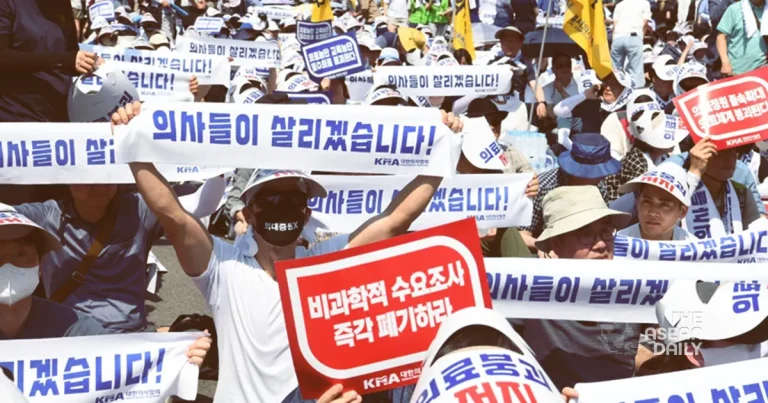19-6-2024 (SEOUL) Tensions between medical professionals and the government reached a boiling point as thousands of doctors affiliated with the Korean Medical Association (KMA), South Korea’s largest coalition of neighbourhood practitioners, launched a nationwide, one-day strike on Tuesday. The strike, which drew an estimated 5,000 to 12,000 participants to a mass rally in Seoul’s Yeouido district, according to police estimates, was a defiant act of protest against the government’s return-to-work order and threat to disband the organisation.
The KMA, representing approximately 140,000 doctors, mostly self-employed practitioners, pleaded with the public that this strike represents the “last chance” to salvage the nation’s healthcare system from the brink of collapse. Lim Hyun-taek, the KMA’s head, vowed to be at the forefront of the battle against the government, warning that doctors will escalate to an indefinite strike starting June 27 if their demands are not met, proclaiming, “We will fight to the end.”
At the heart of the dispute lie three key demands from the KMA: a complete revisiting of discussions on raising the medical school admissions quota, supplementing crucial points in the government’s policy package for essential medical services, and the cancellation of all administrative orders and penalties against junior doctors who have walked off the job since February. However, the government has categorically rejected these demands.
During the rally at Yeouido Hangang Park in western Seoul, Lim Hyun-taek delivered an impassioned speech, declaring, “We doctors will fight to the end until the oppressive government treats doctors as valuable professionals who save lives, not as slaves. … Let’s unite to fight against the government’s dictatorship and save the country’s healthcare.”
Kim Chang-soo, the head of the Medical Professors Association of Korea, echoed similar sentiments, stating that Tuesday’s strike signaled the start of the medical circle’s “fierce battle” against the government, vowing that doctors would continually strive to inform the public about the negative effects of the medical reforms.
The KMA estimated that the walkout would be the biggest since 2000, when doctors protested the government’s policy of separating the prescription and dispensing of drugs at the time. An overwhelming 90.6 percent of its members, including private practitioners and medical professors, voted in favor of the strike.
In an attempt to mitigate the potential medical vacuum, the government ordered doctors to return to work by 9 a.m., as 4.02 percent of the nation’s 36,371 private hospitals had reported their intention to close for the day. Local governments were instructed to monitor whether doctors under their jurisdiction participated in the mass closure, according to the Health Ministry.
President Yoon Suk Yeol condemned the actions of medical professionals, arguing that their collective action could threaten patients’ lives and health. He urged them to engage in dialogue led by the presidential medical reform panel, stating, “Many people, including patients’ groups and from all walks of life, are asking the medical circle to stop its collective action.”
In a separate briefing, Jun Byung-wang, policy chief at the Health Ministry, explained the government’s position that private practitioners taking the day off to participate in the rally amounts to an illegal refusal of treatment. University hospitals, however, remained open to provide medical treatment.
The government warned that if the closure rate of local clinics exceeded 30 percent, on-site inspections would be conducted, and evidence would be gathered to take administrative measures, such as suspending medical licenses, in accordance with the law.
Health Minister Cho Kyoo-hong emphasized that the only way to resolve the issue is through “constructive dialogue and rational discussions rather than engaging in actions that threaten the lives of patients.” He cautioned that doctors who fail to comply could face legal punishment and urged them to abide by their obligations to provide care to patients, stating, “People’s right to life is the most basic, fundamental right that must be protected under any circumstances.”
Jun Byung-wang further threatened that the government could “dissolve” the KMA if it continues to engage in actions that go against the purpose of its establishment, which is to promote public health and welfare and advance medicine.
Despite the government’s threats and patient fears, no major disruptions to healthcare services were reported. Officials at prestigious medical institutions such as Seoul St. Mary’s Hospital and Asan Medical Center in Seoul reported minimal participation in the strike, with many professors continuing to see patients despite their decision to strike.




